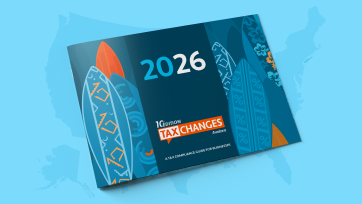
Vermont modernizes communications taxes
Technological advances are improving connectivity, making it easier and faster to communicate and exchange data across great distances. When sixth-generation wireless (6G) arrives, connectivity should become even better. Communications taxes aren’t always as nimble: Changing communications tax policies can be a bit like using a dial-up modem. But Vermont has done it with the passing of H. 657, an act relating to the modernization of Vermont’s communications taxes and fees.
The new law:
- Expands and increases Vermont’s Universal Service Charge
- Repeals Vermont’s telephone tax
- Redefines communications property as real property
Vermont expands and increases Universal Service Charge
Like all states, Vermont imposes a Universal Service Charge (USC) on all retail telecommunications services provided to a Vermont address. The USC funds the Vermont Universal Service Fund, which funds improvements to broadband internet services and helps keep those services affordable for Vermonters. It’s the state’s version of the Federal Universal Service Fund, or FUSF.
USC rates are based on the location of the service, which may or may not be the same as the billing address. For mobile phones, the Universal Service Charge applies when the customer’s place of primary use is in Vermont. The USC is imposed on purchasers but collected by the telecommunications service provider.
The Universal Service Charge isn’t new. However, H. 657 extends the USC to interconnected VoIP services when the customer’s place of primary use is in Vermont. The bill defines “place of primary use” as the street address where the customer’s use of interconnected VoIP service primarily occurs, or a reasonable proxy, such as the customer’s registered location for 911 purposes.
H. 657 also changes the Universal Service Charge rate from 2% of retail telecommunications service to 72 cents for each retail access line in service. The number of access lines is the greater of the number of inbound or outbound two-way communications by any technology provisioned by the provider that the customer can maintain at the same time.
An “access line” is either a wire or wireless connection that:
- Provides voice telecommunications services to or from any device used by a customer;
- Is associated with a 10-digit NPA-NXX number or other unique identifier;
- Has a service location or place of primary use in Vermont; and
- Is capable of accessing the 911 system
The rate changes take effect July 1, 2025. Customers enrolled in the federal and/or Vermont Lifeline program are exempt from the USC.
A Universal Service Charge of 2.4% will continue to apply to all retail sales of prepaid wireless telecommunications services that are subject to Vermont sales and use tax. The fee is to be collected and remitted by the seller or marketplace facilitator responsible for collecting sales tax.
Also new under H. 657:
- A portion of USC revenue will fund Vermont 988 Suicide and Crisis Lifeline centers
- A portion of USC revenue (17%) will be distributed to the Vermont Community Broadband Board
Vermont repeals the telephone tax
There will no longer be a state telephone personal property tax (telephone tax) in Vermont effective July 1, 2025. Taxpayers will need to pay the final monthly installment of the Vermont telephone personal property tax — levied on the net book value of their personal property as of December 31, 2024 — on or before July 25, 2025.
The state’s alternative telephone gross revenues tax will linger a little longer; it will be repealed effective January 1, 2026. The final quarterly payment of the alternative telephone gross revenues tax is due on or before January 25, 2026.
Anyone who was subject to the alternative telephone gross revenues tax prior to its repeal will become subject to the state income tax on or after January 1, 2025, per H. 657. The income tax requirement begins with the taxpayer’s first income tax year.
Applicable inventory and valuation provisions will apply to the Vermont Department of Taxes’ Division of Property Valuation and Review and all communications service providers with taxable communications property in Vermont, starting with fiscal year 2025.
Vermont redefines communications property as “real property”
As noted above, communications property has been treated as business personal property in Vermont. That will soon change. All communications property will be considered real property and “set in the grand list as real estate” effective July 1, 2025; it will apply to grand lists lodged on or after April 1, 2025.
A grand list includes any personal property taxed at the local level. Here’s an example from Winooski, Vermont.
The bill defines “communications property” as “tangible personal property used to enable the real-time, two-way, electromagnetic transmission of information, such as audio, video, and data, that is so fitted and attached as to be part of a local, state, national, or international communications network.” Communications property includes facilities that are part of a cable television system, which includes wires, cables, conduit, pipes, antennas, poles, and wireless towers.
Additional details can be found in the text of H. 657.
If your business is struggling to comply with complex communications taxes in Vermont or other states, Avalara AvaTax for Communications can help. To learn more about Avalara products and services, please contact your account manager or call 844-725-7278.

Avalara Tax Changes 2026 is here
The 10th edition of our annual report engagingly breaks down key policies related to sales tax, tariffs, and VAT.
Stay up to date
Sign up for our free newsletter and stay up to date with the latest tax news.














